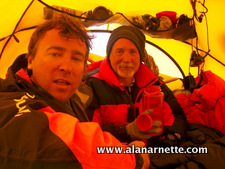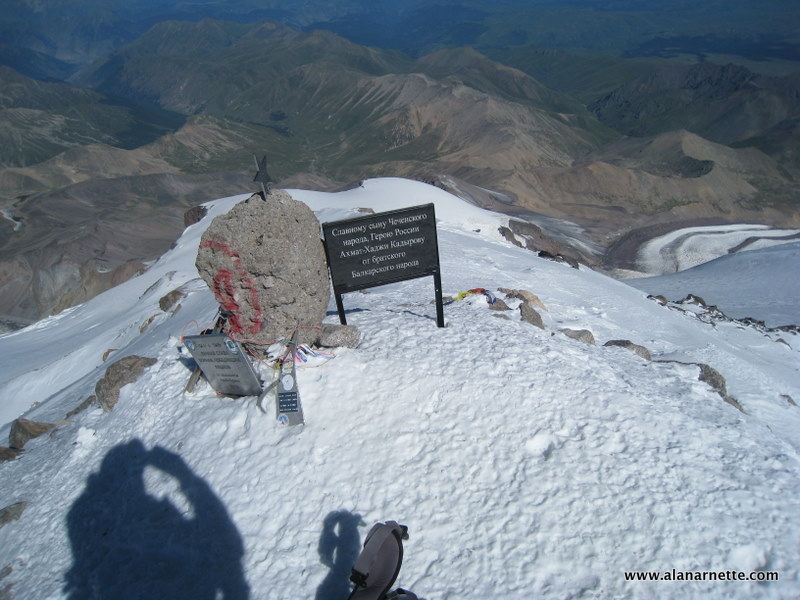Climbing Everest is a thousand tiny decisions and one major one. It all starts with the day you decide to climb – any mountain. As I always say, climbing is a sport you either immediately love or well, s let’s just say that some people never want to sleep in a tent again after that first night!
I was in the love at first climb, so to speak. It was on Mont Blanc, I was standing on the summit and my feelings of accomplishment and satisfaction were enough to fuel a major climb almost every year for the next 18.
Standing on the summit of aesthetically beautiful and technically challenging Ama Dablam, I saw Everest at almost eye level for the first time and, also for the first time, I started to believe it was within my capabilities. Two years later I stood high on her slopes admiring the views back towards Ama Dablam.
What decisions did I make in between? To name a few: training, gear, skills, guides, money, work, family and a million more.
Once on Everest, every decision becomes magnified and the consequences are immediate. Summit night is perhaps the example of an Everest decision that can literally mean life or death.
I arrived at the South Col, about 26,300’ or 8,000 meters in mid afternoon. I was tired. The climb from Camp 3 on the Lhotse Face was long, steep and hot. I was severely dehydrated. Also, I knew I had to pull myself together to leave for the summit bid in a few hours. As I tried to rest, I knew a decision was ahead.
A decision teams make year after year is when to leave for the summit. Leaders have consulted with the weather forecasters back home, with the decades of experience accumulated by the Sherpas and reflecting on their own climb history, they position climbers at the highest camp in the world.
Sitting in our tent, I listened to the wind blowing with an ever increasing force. Not tonight, I could almost hear it scream. Sure enough, we made the call not to go and laid down in full down suits in ?40F down sleeping bags. With four men in a 3 man tent, it was going to be a long 24 hours.
Nearby, we could hear other climbers attaching crampons, packing oxygen bottles in their packs, the low hiss of stoves desperately trying to melt snow at this impossible altitude. Their decision? Go.
On the radio we listened to a guide at Camp 3. He was clear in his decision: “not today – or tomorrow. We are returning to C2 to wait out these winds.”
Another year, the start time was in question. Leave at 6, 8, 10; after midnight? Each has it advantages and dangers.
The goal is to summit Everest just after sunrise. You want to avoid climbing too long in the cold and dark by leaving too early but want to be off the high slopes if or when the weather degrades in the late afternoon.
A key factor is to descend in the warmth and light of the sun. The descent is when most people die primarily due to fatigue. But arriving too early means missing the sunrise shadow of Everest, the views you had planned, dreamed and worked so hard to see; the risk in the darkness of missing a crucial step on a narrow traverse.
Another consideration are the crowds. Hopefully the weather is good for a week or so allowing multiple summit attempts – this is the norm. However, if the weather window is short that year, there can be hundreds of climbers positioned at the South Col scrambling for their one and only shot at the summit.
This can obviously create traffic jams at the notorious bottleneck spots along the Triangular Face to the Balcony, the Cornice Traverse or the Hillary Step on the south side. If you leave too early, you miss the crowds but climb longer in the cold and dark; leave too late and climb too slow you risk the afternoon weather on the descent.
Some teams leave very late, some after midnight. They are fast enough to summit by sunrise, to avoid the crowds at the notorious bottlenecks; but they are the exceptions and risk standing on top too late if something goes amiss.
The story line of 1996 is well known with Rob Hall and Doug Hansen summiting late in the day, after 2:00 PM, and that contributed to their issues as they ran into darkness on the descent. Their experience helped re-enforce the modern day concept of a fixed turn around time.
Every expedition has different thoughts on that time, with some believing anytime before noon is acceptable. Others like to see it no later than 10:00 AM. And for some gamblers, the decision is made during the climb based on a number of facts: weather, health, crowds.
A lot depends on the speed of the climbers. A good friend, Brad Jackson supplied these times for he and his wife’s summit in 2010:
South Col to Balcony – 3 – 4 hours
Balcony to South Summit- 4 – 5 hours
South Summit to Summit – 2 hours
Summit to Camp 4 – 6 hours
Using these times with a summit no later than 10:00AM implies a South Col departure time of 11:00 PM the previous night. Today, most teams leave between 8 and 10 PM.
World-class mountaineer Ed Viesturs once famously said “Getting to the top is optional, getting down is mandatory!” I appreciate once again, my friend Brad’s candid description of he and his wife Sandy’s descent after their successful summit:
… by the time I had hit the south summit, I had caught up with my wife. We ascended the Hillary Step together and summit together. By the time, we returned to the Hillary Step, my wife was not 100% completely lucid, having occasional ‘panic attacks’ and took a big slide off the summit ridge to be saved by the fixed line. In contrast to my performance past the balcony in aiding and assisting in someone needing rescue, I was in no position whatsoever to aid my wife, apart from utter occasional encouragement. The word I use to describe myself from summit descent basically to halfway down to the balcony is feeble. Basically having the energy to sustain myself down but having nothing in reserve. By the time we were on the ridge between south summit and balcony, we had both improved, to the point we I had some more ‘horsepower’ over to assist if necessary..but prior to that point, I had absolutely nothing. For a couple of hours, I couldn’t help my wife.
A thousand decision taken one by one can always be justified, rationalized or revised with history. But the one decision you make whether to go on or turn back is the only one that counts sometimes.
Climb On!
Alan





5 thoughts on “Decisions on Everest”
Always fascinating to follow your efforts and thoughts on climbing and Alzheimer’s. Best wishes on your preparations for and your climb of Everest….
Thanks Dave and Mauri – will do my best as always. STeF -Climb on!!
You either love or hate it and I love every aspect of it!!!
I certainly pray that everything goes well with your climb and that you won’t have to make that ultimate decision.
Great to be able to follow your preparations for Everest – I am sure you will make the right decisions as you head out and head up. I’ll be following you and thinking of you as you climb. Hope these last few weeks of preparation go well. Stay safe!
Comments are closed.